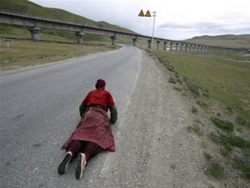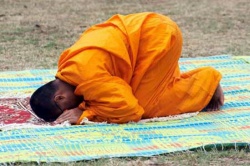Prostration
Jump to navigation
Jump to search
Prostration (Wyl. phyag 'tshal) is the first of the seven branches, and is described as the antidote to pride.
Etymology
Prostration (or homage) in Tibetan is chak tsal (Wyl. phyag 'tshal). According to the oral lineage, the first part, chak (Wyl. phyag), means something like ‘sweeping away’ any harmful actions and obscurations, just as we sweep away dirt and dust using a broom. Then, tsal ( 'tshal), means that we receive the blessings of enlightened body, speech and mind, and gain all the siddhis.
So what do we sweep away and receive?
- When we put our hands to our head, we sweep away all the negative actions and obscurations associated with the body, and we receive the blessings of the enlightened body.
- When we put our hands to our throat, we sweep away all the negative actions and obscurations associated with the speech, and we receive the blessings of enlightened speech.
- When we put our hands to our heart, we sweep away negative actions and obscurations of the mind, and we receive the blessings of enlightened mind.
- When we touch the ground with the five points of our body we purify the five poisons, and we receive the blessings of the five kayas and the five wisdoms.
In Ngöndro Practice
In most ngöndro practices, prostrations are combined with the practice of taking refuge, but in the Longchen Nyingtik Ngöndro they are combined with the Guru Yoga.
Further Reading
- Dilgo Khyentse Rinpoche, Guru Yoga (Ithaca, New York: Snow Lion Publications, 1999), pages 41-43.
- Khenpo Ngawang Pelzang, A Guide to the Words of My Perfect Teacher, translated by Padmakara Translation Group (Boston & London: Shambhala, 2004), pages 268-270.
- Patrul Rinpoche, The Words of My Perfect Teacher, translated by Padmakara Translation Group (Boston: Shambhala, 1998), pages 317-321.


